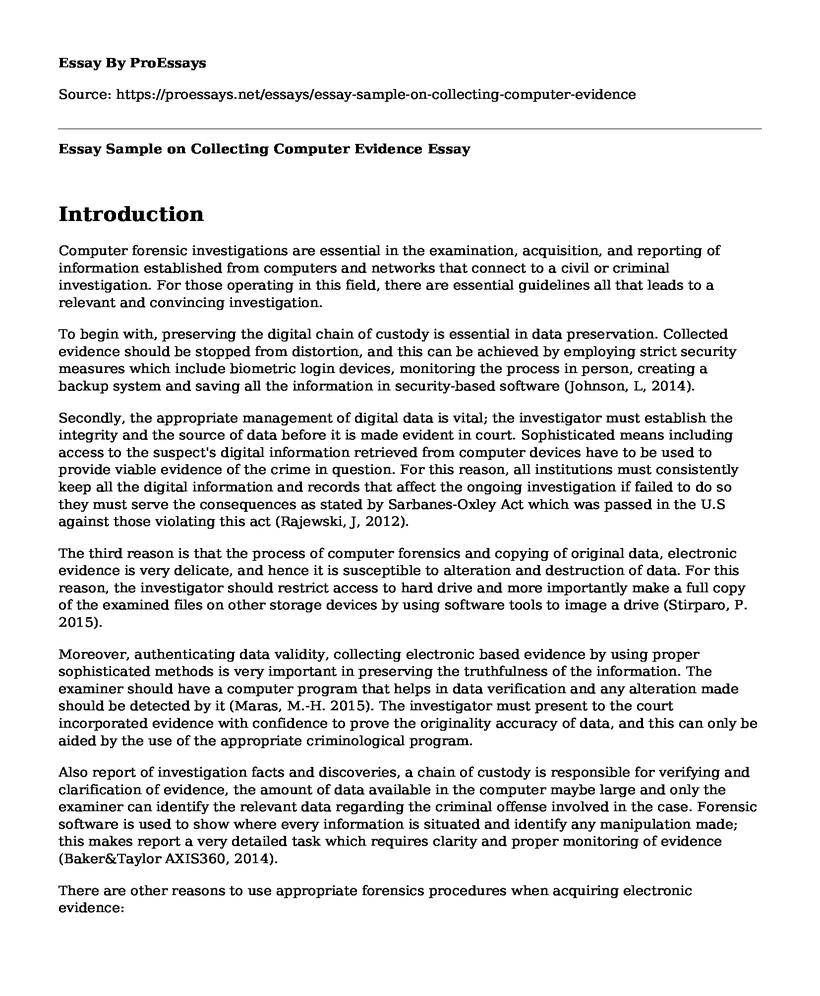Introduction
Computer forensic investigations are essential in the examination, acquisition, and reporting of information established from computers and networks that connect to a civil or criminal investigation. For those operating in this field, there are essential guidelines all that leads to a relevant and convincing investigation.
To begin with, preserving the digital chain of custody is essential in data preservation. Collected evidence should be stopped from distortion, and this can be achieved by employing strict security measures which include biometric login devices, monitoring the process in person, creating a backup system and saving all the information in security-based software (Johnson, L, 2014).
Secondly, the appropriate management of digital data is vital; the investigator must establish the integrity and the source of data before it is made evident in court. Sophisticated means including access to the suspect's digital information retrieved from computer devices have to be used to provide viable evidence of the crime in question. For this reason, all institutions must consistently keep all the digital information and records that affect the ongoing investigation if failed to do so they must serve the consequences as stated by Sarbanes-Oxley Act which was passed in the U.S against those violating this act (Rajewski, J, 2012).
The third reason is that the process of computer forensics and copying of original data, electronic evidence is very delicate, and hence it is susceptible to alteration and destruction of data. For this reason, the investigator should restrict access to hard drive and more importantly make a full copy of the examined files on other storage devices by using software tools to image a drive (Stirparo, P. 2015).
Moreover, authenticating data validity, collecting electronic based evidence by using proper sophisticated methods is very important in preserving the truthfulness of the information. The examiner should have a computer program that helps in data verification and any alteration made should be detected by it (Maras, M.-H. 2015). The investigator must present to the court incorporated evidence with confidence to prove the originality accuracy of data, and this can only be aided by the use of the appropriate criminological program.
Also report of investigation facts and discoveries, a chain of custody is responsible for verifying and clarification of evidence, the amount of data available in the computer maybe large and only the examiner can identify the relevant data regarding the criminal offense involved in the case. Forensic software is used to show where every information is situated and identify any manipulation made; this makes report a very detailed task which requires clarity and proper monitoring of evidence (Baker&Taylor AXIS360, 2014).
There are other reasons to use appropriate forensics procedures when acquiring electronic evidence:
- It enables easy retrieval of lost or deleted data since clone files are available.
- Data is converted into a more user-friendly format while retaining the original metadata.
- Enhances clarity and integrity of evidence
Subjects in a case may not be interfered with not until proven guilty, and this is because the collection of evidence in this method does not necessarily require the physical appearance of the suspect.
References
Johnson, L. (2014). Computer incident response and forensics team management: Conducting a successful incident response. Waltham, MA: Syngress.
Sammons, J., & Rajewski, J. (2012). The basics of digital forensics: The primer for getting started in digital forensics. Waltham, MA: SyngressEpifani, M., & Stirparo, P. (2015). Learning iOS forensics: A practical hands-on guide to acquire and analyze iOS devices with the latest forensic techniques and tools. Birmingham, UK: Packt Publishing.
Maras, M.-H. (2015). Computer Forensics: Cybercriminals, laws, and evidence, second edition. Burlington, MA: Jones & Bartlett Learning.
Brooks, C. L., & Baker&Taylor AXIS360. (2014). CHFI computer hacking forensic investigator certification: All-in-one exam guide.
Cite this page
Essay Sample on Collecting Computer Evidence. (2022, Nov 14). Retrieved from https://proessays.net/essays/essay-sample-on-collecting-computer-evidence
If you are the original author of this essay and no longer wish to have it published on the ProEssays website, please click below to request its removal:
- Juvenile Justice Questions
- Crime Prevention Through Environmental Design Essay
- Proposal for the Use of Stab Resistant Vest in the Prison Paper Example
- The Debate Against Human Right on Torture Essay Example
- Research Paper on Rising Healthcare Costs in Prisons: Elderly, Poor, Women, Mental Health
- 1960s Unrest Repeats Itself: Protests, Wars, Turmoil Today - Essay Example
- Mental Illness & Imprisonment: A Research Proposal Example







